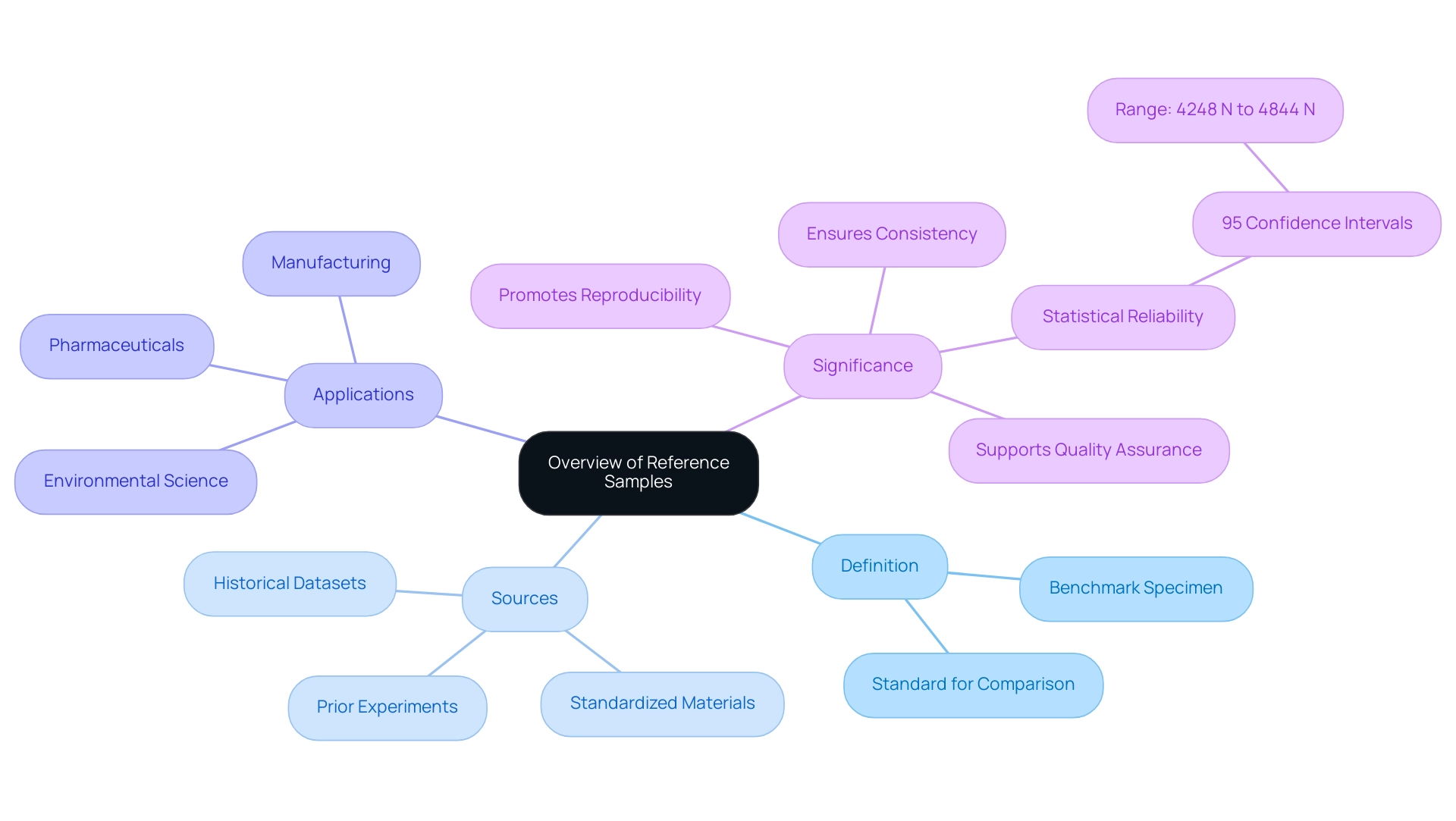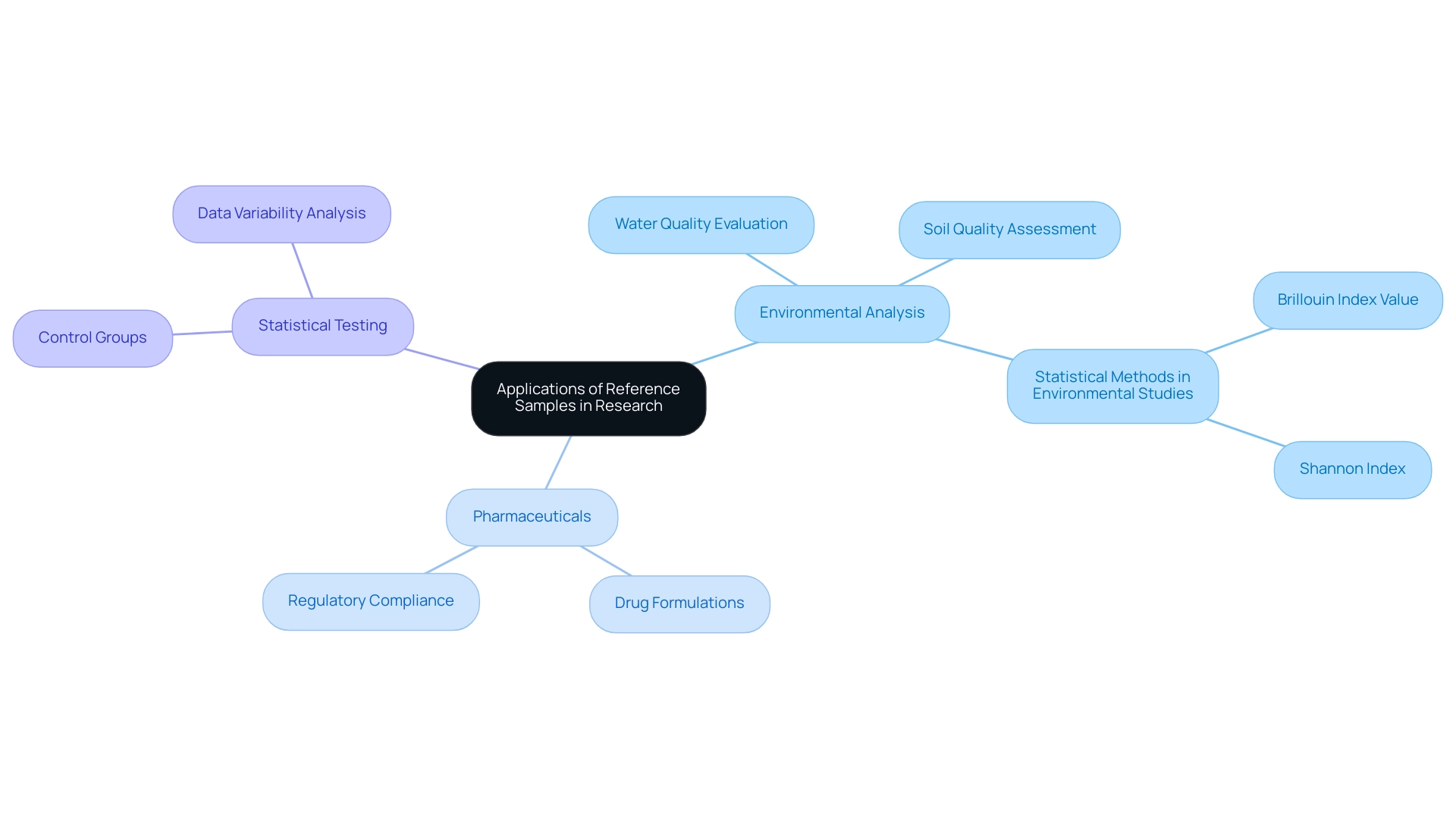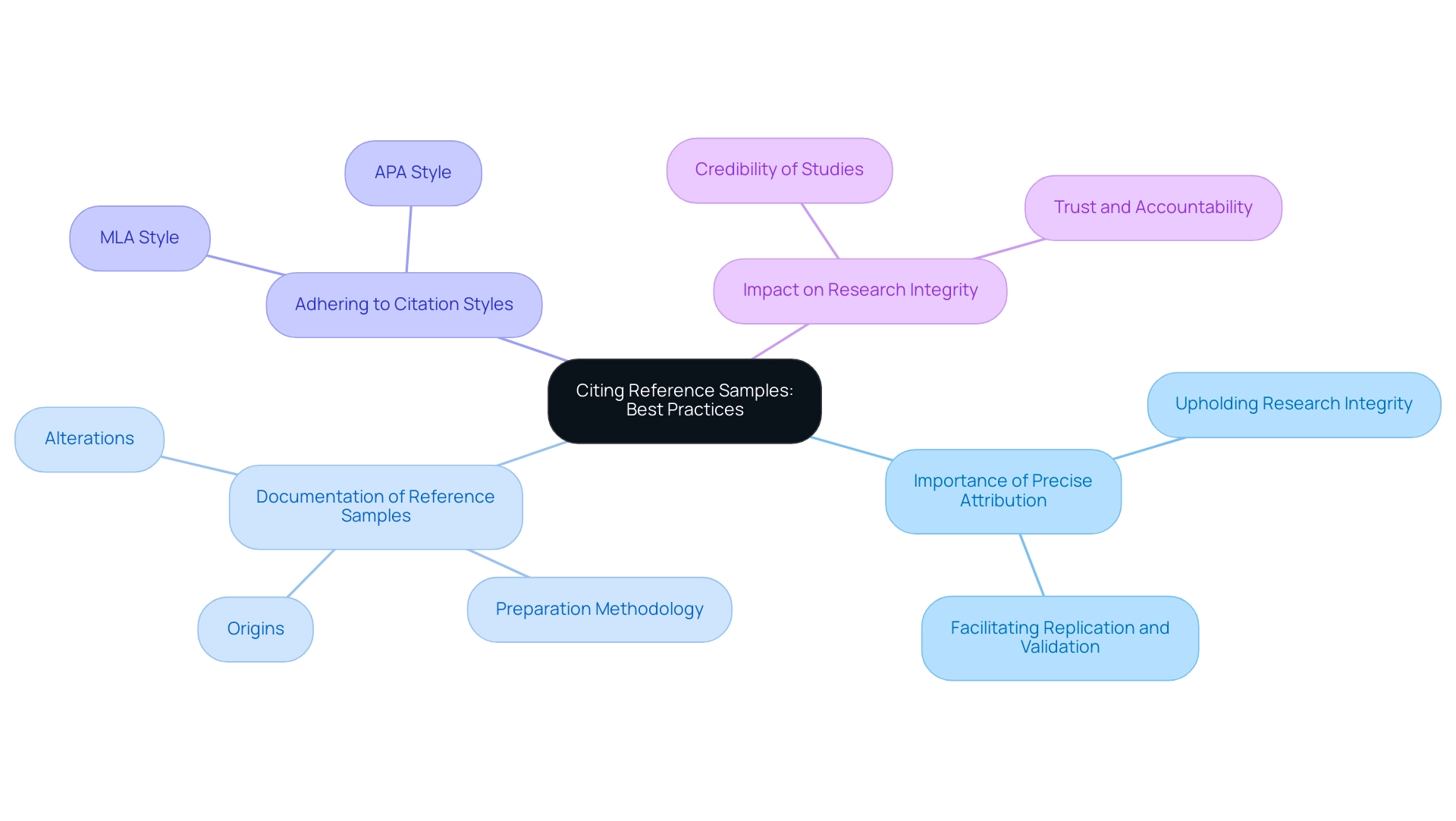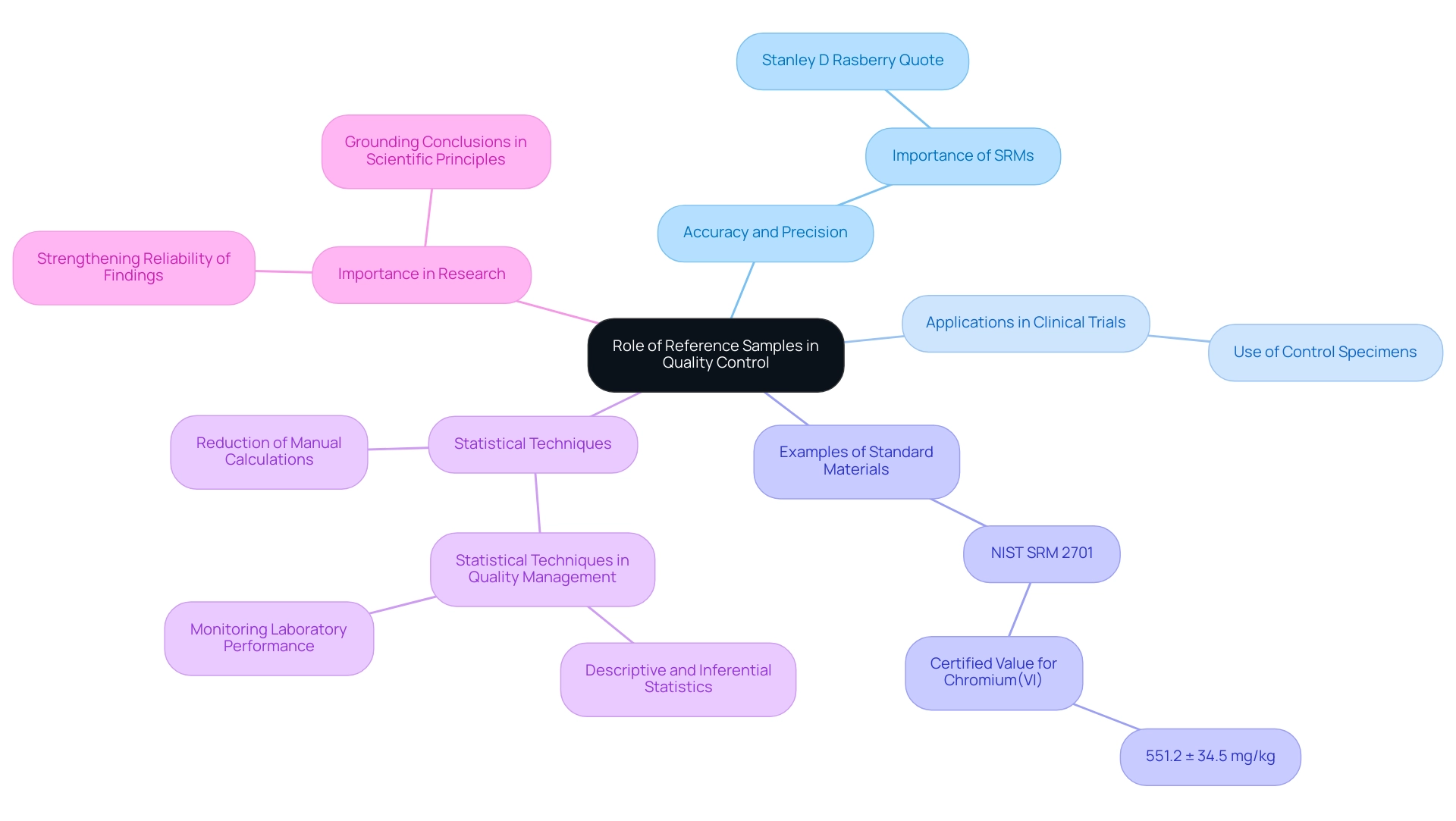What Is a Reference Sample? A Comprehensive Overview
Discover what a reference sample is and its vital role in research and quality assurance.

Overview:
A reference sample is a benchmark specimen used for comparison in analytical processes, essential for ensuring accuracy and reliability in scientific research across various disciplines. The article highlights their critical role in quality control, environmental assessments, and pharmaceuticals, emphasizing that proper documentation and adherence to best practices are necessary to uphold research integrity and facilitate reproducibility.
Key Highlights:
- Reference samples serve as benchmarks for comparison in analytical processes, essential for confirming results in scientific investigations.
- They originate from various sources, including historical datasets and standardized materials, and are crucial for maintaining consistency and reliability in findings.
- Applications of reference samples span multiple disciplines, particularly in environmental science for evaluating contamination levels and in pharmaceuticals for ensuring drug safety.
- Best practices for citing reference samples include detailed documentation of their origins and preparation, which bolsters research integrity and facilitates replication.
- Reference samples play a vital role in quality control, ensuring accuracy and precision in experimental methods, particularly in clinical trials and analytical testing.
- Challenges in selecting reference samples include sourcing high-quality materials and preventing contamination, which can compromise research integrity.
- Implementing strict adherence to protocols and conducting on-site inspections can mitigate quality-related issues in research.
Introduction
In the intricate landscape of scientific research, reference samples emerge as critical components that underpin the validity and reliability of experimental outcomes. These specimens serve not only as benchmarks for comparison but also as essential tools for quality assurance across diverse fields, from environmental science to pharmaceuticals.
As researchers navigate the complexities of data analysis and interpretation, the significance of accurately selected reference samples cannot be overstated. They not only facilitate the establishment of standards but also enhance the credibility of findings, fostering reproducibility and trust within the scientific community.
This article delves into the multifaceted role of reference samples, exploring their applications, best practices for citation, and the challenges researchers face in their selection and utilization, ultimately underscoring their vital importance in advancing scientific integrity.
Defining Reference Samples: An Overview
A benchmark specimen is a specimen or a collection of specimens that serves as a standard for comparison in analytical processes and experiments. In the field of scientific investigation, understanding what is a reference sample is essential for confirming results, as it sets a benchmark against which the caliber and precision of test outcomes can be evaluated. These specimens may originate from various sources, including historical datasets, standardized materials, or prior experiments, and find application across multiple disciplines such as environmental science, pharmaceuticals, and manufacturing.
Their significance cannot be overstated, as they ensure consistency and reliability in findings, which raises the question of what is a reference sample as a fundamental component of quality assurance protocols. Recent conversations among the scientific community highlight the need for benchmark materials, leading to discussions on what is a reference sample, and stressing their importance in improving the reliability of findings and promoting reproducibility in experimental methods. As Silvello points out, motivations for data citations, such as accountability and validation, emphasize the vital role of benchmark materials in upholding research integrity.
Moreover, the 95% confidence intervals for 100 specimens vary from 4248 N to 4844 N, demonstrating the quantitative aspect of reliability linked with benchmark specimens. Furthermore, the case study titled 'Challenges of Large Sample Sizes' contends against the widespread notion that larger groups are always preferable, examining how overly large groups can yield statistically significant outcomes that lack clinical importance, thus emphasizing the necessity for suitable reference groups in assurance of standards.

Applications of Reference Samples in Research and Analysis
Understanding what is a reference sample is crucial as reference specimens play an important role across various disciplines, particularly in environmental analysis and pharmaceuticals. In environmental contexts, these specimens are indispensable for evaluating water and soil quality, allowing researchers to compare test results against established standards to ascertain contamination levels or environmental health. Practical collection considerations and strategies for environmental investigations are central to this process, as they guide the selection and use of benchmark materials.
Environmental scientists emphasize what is a reference sample by highlighting the significance of benchmark materials in ensuring precise evaluations. As noted in the quote, 'Truth, Damn Truth and Statistics,' the application of statistical methods is vital in this field. In academic research, benchmark materials help to explain what is a reference sample, offering a foundation for new studies and establishing criteria that direct the validity and reliability of findings.
Furthermore, in statistical testing, they serve as control groups, enabling researchers to understand data variability and enhance the robustness of their conclusions. The Brillouin index value, which is seldom greater than 4.5, highlights the importance of these specimens in maintaining analytical precision. The pharmaceutical sector illustrates the essential dependence on benchmark materials, ensuring that drug formulations adhere to regulatory criteria for safety and effectiveness.
A case study on the interdisciplinary collaboration between Environmental Sciences and Statistics demonstrates the practical use of statistical techniques in tackling environmental concerns, emphasizing the significance of benchmark specimens in this context. This multifaceted utility of benchmark materials underscores their vital significance in maintaining quality and consistency across diverse fields, reinforcing the necessity for rigorous collection plans and statistical methods.

Citing Reference Samples: Best Practices and Guidelines
Precise attribution of source materials is crucial for upholding research integrity. Best practices dictate that researchers provide detailed information about what is a reference sample, including its origins, preparation methodology, and any relevant characteristics that could influence study outcomes. For instance, in a study with a population represented as n = 42, documenting these details becomes even more critical.
Adhering to established citation styles, such as APA or MLA, tailored to one's discipline, is crucial. Moreover, recording any alterations made to the control specimen during testing is crucial for clarifying what is a reference sample, as such modifications can greatly influence the reproducibility of outcomes. By implementing these guidelines, researchers not only bolster the credibility of their studies but also contribute to the broader scientific landscape, facilitating replication and validation of findings.
The importance of accurate representation is exemplified by the Amah Mutsun Tribal Band's collaborative efforts in land acknowledgment. As the Chairman stated, 'This land acknowledgment serves as a reminder of our connection to this territory and the ongoing work of healing through traditional practices.' This emphasizes that the integrity of scholarly practices is foundational for fostering trust and accountability within the academic community, particularly in recognizing historical trauma.

Quality Control: The Role of Reference Samples in Scientific Research
In the field of scientific inquiry, benchmark materials are essential for upholding quality control, serving as vital standards for validation. These specimens are pivotal in evaluating both the accuracy and precision of experimental methods, thereby guaranteeing that results are both reliable and reproducible. For example, during clinical trials, control specimens with known concentrations are frequently employed to confirm the effectiveness of analytical methods.
This practice is essential for detecting discrepancies in results and plays a vital role in calibrating testing instruments. As noted by author Stanley D Rasberry,
But users must be cautioned never to assume that good precision implies accuracy, without the confirmation by SRMs.
A specific example of standard materials is the NIST SRM 2701, which has a certified value for chromium(VI) of 551.2 ± 34.5 mg/kg, underscoring the importance of precise standards in research.
Furthermore, concerns about analyte removal efficacy from non-aqueous matrices should be approached on a matrix- and species-specific basis, as these factors can significantly influence the reliability of results. By incorporating benchmark specimens into their methodologies, researchers not only strengthen the reliability of their findings but also guarantee their conclusions are firmly grounded in sound scientific principles. Furthermore, improvements in statistical software tools have minimized the need for manual calculation of intervals, simplifying the process of control.
Statistical techniques, such as those highlighted in the case study 'Statistical Techniques in Quality Management,' showcase how employing these methods allows laboratories to monitor performance and uphold high standards of accuracy in test results. This rigorous approach highlights the importance of benchmark specimens in promoting reliability across experimental methods.

Challenges in Selecting and Utilizing Reference Samples
Choosing and employing benchmark materials presents considerable difficulties that can influence research results, especially regarding quality assurance for D2C brands. A primary concern is the availability of high-quality reference materials, as understanding what is a reference sample is crucial for making accurate comparisons. Researchers often encounter difficulties in sourcing specimens that truly represent the population under study, potentially leading to biases in their results.
To mitigate these issues, implementing on-site inspections can prevent up to 60% of quality-related returns, a critical strategy for protecting brand reputation. Moreover, it is essential to recognize that 94% of customers have avoided making a purchase due to a bad review, underscoring the need for stringent quality assurance practices. The preparation and handling of these specimens necessitate strict adherence to protocols, as any lapse can result in contamination or degradation, jeopardizing their integrity.
Statistics suggest that contamination rates during handling of control materials can reach alarming levels, emphasizing the importance of this issue in preserving integrity in studies. Furthermore, it is essential that researchers evaluate the significance of the sample used in their specific study; using an unsuitable sample can yield misleading conclusions. The 2022 Deloitte Global Outsourcing Survey highlights that 54% of business leaders regard transparency as the most crucial attribute in suppliers, illustrating the significance of dependable sourcing in research.
Companies such as Unilever implement sustainable farming principles to guarantee transparency and foster trust with their suppliers, which can assist in sourcing high-quality materials. OpsNinja employs rigorous quality assurance methodologies, including comprehensive inspections and detailed reporting, to ensure that what is a reference sample meets the highest standards. By acknowledging these challenges and striving for transparency and quality—alongside proactive measures like on-site inspections—researchers can enhance their methodologies, ensuring that their findings are both valid and reliable.
As Xihong Lin aptly states, 'A Call for Broader and Deeper Engagement in Data Science,' emphasizing the need for a comprehensive approach in addressing these challenges.

Conclusion
Reference samples are foundational to the integrity of scientific research, serving as benchmarks that ensure the accuracy and reliability of experimental outcomes. Their multifaceted applications span various disciplines, including environmental science and pharmaceuticals, where they facilitate the assessment of quality and compliance with standards. By establishing clear metrics for comparison, reference samples enhance the credibility of research findings and support reproducibility, which are essential for fostering trust within the scientific community.
However, the selection and utilization of reference samples come with challenges that researchers must navigate. Access to high-quality materials, adherence to strict handling protocols, and the need for appropriate sample relevance are critical to maintaining integrity in research. Strategies such as on-site inspections and rigorous quality assurance methodologies can mitigate risks associated with contamination and bias, ultimately leading to more reliable results.
In summary, the role of reference samples cannot be overstated. They are not merely supportive tools; they are integral to the validation processes that uphold the standards of scientific inquiry. As research continues to evolve, the commitment to using well-defined and accurately cited reference samples will remain paramount in advancing the reliability and credibility of scientific endeavors. Thus, prioritizing these practices is essential for researchers aiming to contribute meaningfully to their fields and uphold the principles of scientific integrity.



